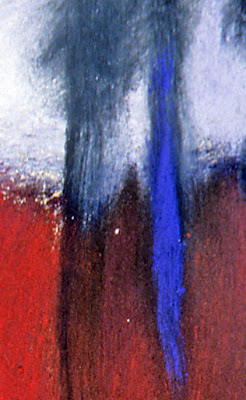Say what you will, the French have certainly cornered the art media market, big time. I cannot do without my Sennelier pastels ( A L'Ecu ) and my La Carte sanded paper.
Oh yes, I suppose one could stay with some very excellent American products and make out quite well. For instance, I feel that the Diane Townsend Artist's Pastels (Pennsylvania) and the Kitty Wallis' ( Oregon) Sanded papers are maybe the best products in their field anywhere.
But, when I scumble a DT Terrage pastel over the vegetable matter surface of a La Carte card, I have experienced a technique that is unrepeatable, to my knowledge, by any other set of tools. The Wallis is superior for other things, but not that particular move.
And, those Sennelier extra soft pastels are the best for keeping to the original characteristics of each pigment as much as possible. Sure, the sticks break easier in certain colors. But it is all about the color, isn't it? It's better, in Gustave Senneliers' mind (by modern extension, his company's collective mind) to keep the color of the pigment, than to satisfy the needs of consistent handling from stick to stick.
This is as close to artistic integrity as it can get, I think. It's absolutely none of my business, but if I were a Frenchman, I would want a Sennelier for President of France.
I am no chemist, nor am I anything more than a punter when it comes to making pastel sticks, but I hold the Diane Townsends and the Sennelier up as my two favorite sticks. Why not stay with just the DT's, which have the more pleasing shapes and overall characteristics? Because there are certain intensities of color that Sennelier has that I find no where else. Also, those big, monster size Sennelier sticks are off the hook.
Sure, Sennelier sticks are expensive, but when I purchase powdered pigment at retail, and roll my own sticks, the value of how much blue is in a Sennelier Ultramarine pastel stick becomes well apparent. In fact, when I find a Senneleir standard or jumbo stick on sale, I feel that the thing is coming to me at a net loss to Sennelier. That is when compared to what it costs me to buy the pigment to make them, without even factoring in the cost of my labor. Until I find a shipwreck of pigment jars washed up at the beach, or figure out which dumpster to dive to get pigment cheaper, the Senneliers seem like a great value to me.
Postscript: The Jerry's Artarama link (jumbo) above has an old picture of the Jumbo Senneliers in a wood box. Those are not being produced, I understand, and are replaced by the La Grande, which is still a big stick. I have some of all three sizes, and the monster ones rock. If you find some on clearance, buy them. You are taking them at way under cost.
Subscribe to:
Post Comments (Atom)
Abstract Expressionism, Art Criticism, Artists, Colorist Art, Drawing, History, Impressionism, Modern Art, Painting, Pastel, Post Impressionism






















4 comments:
Wonderful work Casey! I LOVE IT!
Thanks, friend!
I love my Senneliers, especially the dark colors.
So far, I've had only one red that was hard enough to scratch Wallis, and it was replaced with another red I like better anyway. On the other hand, my 182 green crumbles into little pieces when I look at. The rest of them perform as expected.
You might also like Mount Vision #511 or #512.
I prefer pastels over other mediums because of the intensity of the colors.
You know, I don't know if I use any of Senn. dark colors. The DT darks are so dark, I have to make sure I get them back in the palette in the proper place. They are so close to black.
Yet, it makes a big difference on the painting.
Thanks for the comments, Lisa.
Post a Comment